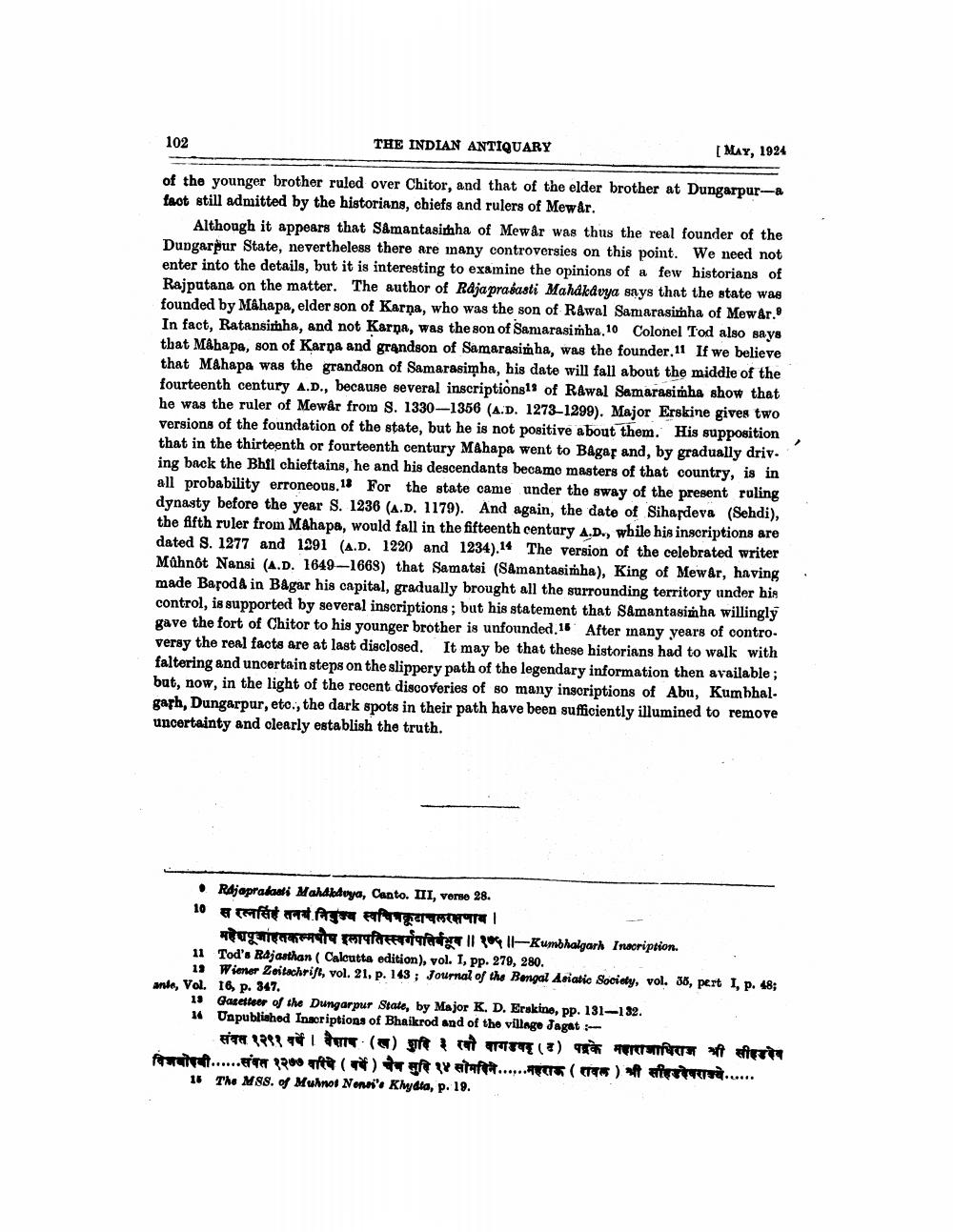________________
102
THE INDIAN ANTIQUARY
[ MY, 1924
of the younger brother ruled over Chitor, and that of the elder brother at Dungarpur-a taot still admitted by the historians, chiefs and rulers of Mewar.
Although it appears that Samantasithha of Mewar was thus the real founder of the Dungarpur State, nevertheless there are many controversies on this point. We need not enter into the details, but it is interesting to examine the opinions of a few historians of Rajputana on the matter. The author of Raja prasasti Mahdkdvya says that the state was founded by Mahapa, elder son of Karna, who was the son of R&wal Samarasimha of Mewâr. In fact, Ratansitha, and not Karpa, was the son of Samarasimha 10 Colonel Tod also says that Mahape, son of Karna and grandson of Samarasimha, was the founder 11 If we believe that Mahapa was the grandson of Samarasimha, his date will fall about the middle of the fourteenth century A.D., because several inscriptions19 of Rawal Samarasimha show that he was the ruler of Mewar from S. 1330-1356 (A.D. 1273-1299). Major Erskine gives two versions of the foundation of the state, but he is not positive about them. His supposition that in the thirteenth or fourteenth century Mahapa went to Bagap and, by gradually driv. ing back the Bhil chieftains, he and his descendants becamo masters of that country, is in all probability erroneous. 18 For the state came under the sway of the present roling dynasty before the year S. 1236 (A.D. 1179). And again, the date of Sihardeva (Sehdi), the fifth ruler from Mahapa, would fall in the fifteenth century A.D., while his inscriptions are dated 8. 1277 and 1291 (A.D. 1220 and 1234).14 The version of the celebrated writer Mähnôt Nansi (A.D. 1649-1669) that Samatsi (Samantasińha), King of Mewar, having made Bafod in Bagar his capital, gradually brought all the surrounding territory under his control, is supported by several inscriptions; but his statement that Samantasimha willingly gave the fort of Chitor to his younger brother is unfounded, 15 After many years of contro. versy the real facts are at last disclosed. It may be that these historians had to walk with faltering and uncertain steps on the slippery path of the legendary information then available; bat, now, in the light of the recent discoveries of so many inscriptions of Abu, Kumbhal. garh, Dungarpur, eto, the dark spots in their path have been sufficiently illumined to remove uncertainty and clearly establish the truth.
• Rajapradaai Mahaldeya, Canto. III, vome 28. 10 सरत्नसिंह तनय निबन्ध स्वचित्रकूटाचलरक्षणाव | U
n ele theftiger II 11-Kumbhalgarh Inscription. 11 Tod's Rajasthan ( Calcutta edition), vol. I, pp. 279, 280.
13 Wiener Zoitschrift, vol. 21, p. 143 ; Journal of the Bengal Asiatic Society, vol. 38, pert I, p. 48; anta, Vol. 16, p. 347.
18 Gasetter of the Dungarpur State, by Major K. D. Erakino, pp. 131-132. 14 Unpublished Inscriptions of Bhaikrod and of the village Jagat
संवत १२९१ वर्षे । वैशाप (ख) शुदिप खो बागडप (द) पदके महाराजाधिराज श्री सीहरदेव ......NITT 1300 ( ) # letata...... ( T )
..... 16 The MSS. of Munnot Nonni's Klydia, p. 19.




